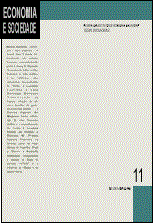Resumo
O objetivo deste artigo foi identificar as principais interpretações da crise asiática e especialmente da coreana. Enfatizaram-se os aspectos estruturais responsáveis pela fragilidade externa destas economias. A liberalização financeira e o declínio do IDE japonês foram destacados e relacionados com a nova paridade do iene relativo ao dólar a partir de 1994
Abstract
This paper discusses the financial crises of Southeast Asia and specially Korea. The objective was to analyze the structural aspects that undermined the external situation of those countries. The financial liberalization and the decreasing of the Japanese FDI were emphasized as important factors. These factors were related with the new parity of yen vis-à-vis dollar occurred in 1994.
Key-words: Financial crises – Southeast Asia, Korea. Financial liberalization
Referências
AKYÜZ, Y. The East Asian financial crisis; back to the future? (http://www.unctad/prasia98). 1998.
AMSDEN, A. Why isn’t the whole world experimenting with the East Asian model to develop? World Development, v. 22, n. 4, 1994.
CHAKRAVARTY, S. Marxist economics and contemporary developing economies. In: WRITINGS on development. Oxford: Oxford Univ. Press, 1997.
CHANG, H. J. Perspective on Korea. Los Angeles Times, 31 Dec. 1997.
CORNFOLD, A. Selected features of financial sectors in Asia and their implications for services trade. UNCTAD, 1997. (Discussions Papers, n. 129).
CUNHA, A. O Pacífico Asiático; da integração econômica dos anos 80 e 90 à crise. (Apresentado no III Encontro de Economia Política, Niterói, maio 1998).
FISHER. The Asian crisis; a view from the IMF (http:www.imf.org/external/mp speeches/1998/012298html). 1998.
HAGGARD, S., MAXFIELD, S. The political economy of financial internationalization in the developing world. In: KEOHANE, R., MILNER, H. Internationalization and domestic politics. Cambridge Univ. Press, 1996.
KOSAI, Y. Competition and competition policy in Japan; foreign pressures and domestic institutions. In: BERGER, S., DORE, R. National diversity and global capitalism. London: Cornell Univ. Press, 1996.
KRUGMAN, P. What happened to Asia. (http://web.mit.edu/www/disinter html). 1998.
LIU, L., NOLAND, M., ROBINSON, S., WANG, Z. Asian competitive devaluations. 1998. (IIE Working Papers, 1998-2).
LOPEZ, J. Mexico’s crisis; financial modernization and financial fragility. Banca Nazionale del Lavoro – Quarterly Review, n. 201, Jun. 1997.
LORENZ, D. Newly industrialising countries in the world economy; NICS, SICs, NECs, EPZs or Tes? In: HOLTFRERICH, C. L. The interactions on the world economy. New York: Harvester Wheatsheaf, 1989.
MEDEIROS, C. A. Globalização e a inserção internacional diferenciada da Ásia e da América Latina. In: TAVARES, M. C., FIORI, J. L. Poder e dinheiro. Petrópolis: Vozes, 1997.
NAKAO, S. Booming Asia reconsidered. Osaka City University Review, v. 32, n. 1.2, 1997.
NOLAND, M. Reestructuring Korea’s financial sector for greater competitiviness. 1996.
(APEC, Working Paper, 96/14).
SATO, Y., HATTORI, T. A comparative study of development mechanisms in Korea and Taiwan; introductory analysis. The Developing Economies, v. 35, n. 4, Dec. 1997.
SUGISAKI, S. Economic crisis in Asia. 1998.
WORLD BANK. The East Asian miracle. 1993.
YAMAZAWA, T., NOHARA, O., OSADA, H. Economic interdependence in Pacific Asia; an international input-output analysis. The Developing Economies, v. 23, n. 24, 1986.
A Economia e Sociedade utiliza a licença do Creative Commons (CC), preservando assim, a integridade dos artigos em ambiente de acesso aberto.

